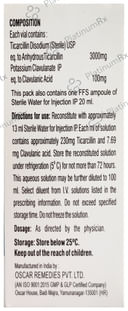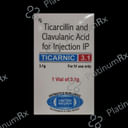Clavulanic Acid + Ticarcillin
Uses
Ticarcillin and Clavulanic Acid are used in the treatment of bacterial infections.
How it Works
How Ticarcillin and Clavulanic Acid work Ticarcillin and Clavulanic Acid is a combination of two medicines: Ticarcillin and Clavulanic Acid. Ticarcillin is an antibiotic that works by preventing the formation of the bacterial protective covering, which is essential for the survival of bacteria. Clavulanic Acid is a beta-lactamase inhibitor that reduces resistance and enhances the activity of Ticarcillin against bacteria.
Side Effects
Common side effects of Ticarcillin and Clavulanic Acid include rash, vomiting, allergic reactions, nausea, and diarrhea.
Expert Advice
- You have been prescribed this combination medicine to treat bacterial infections, even if they have developed resistance.
- Finish the prescribed course, even if you start to feel better. Stopping it early may cause the infection to return and become harder to treat.
- Diarrhea may occur as a side effect. Taking probiotics along with Ticarcillin + Clavulanic Acid may help.
- Talk to your doctor if you notice bloody stools or develop abdominal cramps.
- Take it with food and plenty of fluids to avoid an upset stomach.
- Stop taking Ticarcillin + Clavulanic Acid and inform your doctor immediately if you develop:
- An itchy rash
- Swelling of the face, throat, or tongue
- Breathing difficulties
- Do not use leftover medicine for treating any infection in the future.
- Always consult your doctor before taking any antibiotic.
Related Medications
Clavulanic Acid 100mg + Ticarcillin 3000mg

₹1,197

₹688
MRP ₹839.1
Clavulanic Acid 100mg + Ticarcillin 3000mg

₹900

₹688
MRP ₹839.1
Clavulanic Acid 100mg + Ticarcillin 3000mg

₹1,199

₹688
MRP ₹839.1
Clavulanic Acid 100mg + Ticarcillin 3000mg

₹1,003

₹688
MRP ₹839.1
Clavulanic Acid 100mg + Ticarcillin 3000mg

₹1,549

₹688
MRP ₹839.1
Clavulanic Acid 100mg + Ticarcillin 3000mg

₹1,350

₹688
MRP ₹839.1
Clavulanic Acid 100mg + Ticarcillin 3000mg

₹638

₹688
MRP ₹839.1
Clavulanic Acid 100mg + Ticarcillin 3000mg

₹100

₹688
MRP ₹839.1
Clavulanic Acid 100mg + Ticarcillin 3000mg

₹924

₹688
MRP ₹839.1
Clavulanic Acid 100mg + Ticarcillin 3000mg

₹999

₹688
MRP ₹839.1
Clavulanic Acid 100mg + Ticarcillin 3000mg

₹1,177

₹688
MRP ₹839.1
Clavulanic Acid 100mg + Ticarcillin 3000mg

₹906

₹688
MRP ₹839.1
Clavulanic Acid 100mg + Ticarcillin 3000mg

₹1,200

₹688
MRP ₹839.1
Clavulanic Acid 100mg + Ticarcillin 3000mg

₹2,000

₹688
MRP ₹839.1
Clavulanic Acid 100mg + Ticarcillin 3000mg

₹795

₹688
MRP ₹839.1
Clavulanic Acid 100mg + Ticarcillin 3000mg

₹995

₹688
MRP ₹839.1
Clavulanic Acid 100mg + Ticarcillin 3000mg

₹885.7

₹688
MRP ₹839.1
Clavulanic Acid 100mg + Ticarcillin 3000mg

₹909

₹688
MRP ₹839.1
Clavulanic Acid 100mg + Ticarcillin 3000mg

₹995

₹688
MRP ₹839.1
Clavulanic Acid 100mg + Ticarcillin 3000mg

₹688
MRP ₹839.1
Clavulanic Acid 100mg + Ticarcillin 3gm

₹899
Clavulanic Acid 125mg + Ticarcillin 3000mg

₹865
Clavulanic Acid 100mg + Ticarcillin 300mg

₹1,050
Clavulanic Acid 31.5mg + Ticarcillin 3000mg

₹3,450
Clavulanic Acid 1000mg + Ticarcillin 3000mg

₹950